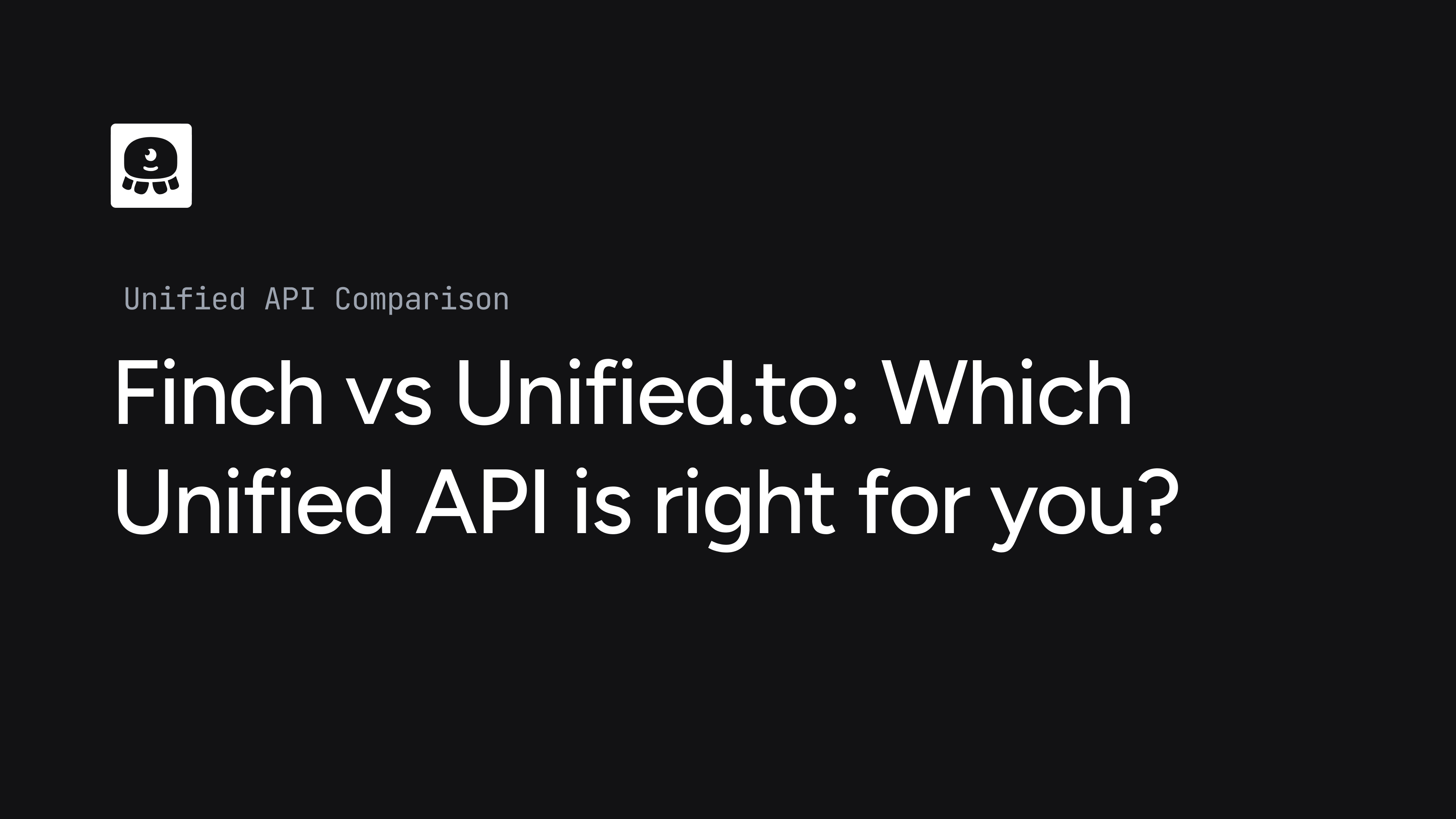Finch vs. Unified.to: which Unified API handles employment data and real-time workflows better?
May 28, 2025

Finch helps developers pull structured HR and payroll data from employment systems. Unified.to helps teams sync real-time data across dozens of categories—including HR—to power live products, AI features, and analytics pipelines.
If you're only working with payroll or HRIS systems, Finch can be a solid choice. But if your product needs broader coverage, fresher data, or better developer control, Unified.to gives you more to work with.
At a glance: Unified.to vs Finch
Finch specializes in employment systems. Unified.to is built for live products that need to move fast across categories like HR, CRM, ATS, and more.
Unified.to gives you:
- Real-time updates (via native + virtual webhooks)
- 270+ integrations across 20 categories
- Normalized schemas with passthrough and custom field support
- Database sync with structured records across systems
- Zero-data architecture: no caching, no customer data stored
- Transparent usage-based pricing
Real-time by default—not once-a-day syncs
Finch fetches data daily (or weekly for some systems). You can trigger a manual refresh or wait for the next scheduled sync. Real-time webhooks are only available on premium plans and still rely on batch jobs in the background.
Unified.to fetches data live from the source—no background jobs or stale cache. Webhooks are built-in. If the system supports native events, Unified.to streams them directly. If not, Unified.to emulates webhooks with high-frequency polling and normalized event delivery.
You don't manage CRON jobs. You just receive consistent, structured webhooks when data changes.
Broad integration coverage, not just HR
Finch only supports employment data: HRIS, payroll, benefits, and employment verification.
Unified.to supports 270+ integrations across 20 categories:
- HRIS and payroll (e.g., BambooHR, ADP, Workday)
- CRM (e.g., Salesforce, HubSpot)
- ATS (e.g., Greenhouse, Lever)
- File storage, calendars, marketing tools, and more
This means one integration provider can handle multiple needs—no context switching, no duplicate tooling.
Customer Spotlight: Humi
Humi, a leading Canadian HR software company, needed to streamline employee onboarding by integrating with 25+ HRIS systems. Their internal estimate was 3–6 months per integration—up to 7+ years of engineering time.
Instead, Humi shipped all 25 HRIS integrations in just one month using Unified.to. No polling. No custom ETL. Just normalized employee data, provisioned in real time.
"Unified is impressively fast at responding to our integration requests and adding them within days. Offering direct integrations through Unified.to brings tremendous value to our customers."
— Kevin Kliman, CEO, Humi
Unified schemas—with escape hatches
Finch provides a consistent data model for employees, pay runs, and benefits. It's solid if you're only dealing with employment data.
Unified.to normalizes data across every category it supports. Each domain (HR, CRM, etc.) has its own schema with standardized fields, relationships, and enums.
You also get:
- Custom fields
- Original/raw fields
- Passthrough API to fetch anything outside the unified model
No waiting for schema updates. No lost data. No tradeoffs.
Database-ready delivery
Finch requires you to build your own ingestion layer. You fetch data via API or webhook and write to your own store.
Unified.to offers built-in Database Sync:
- Connect Postgres, MongoDB, MySQL, and more
- Unified.to keeps your tables updated in real-time
- No polling, no transformation, no ETL jobs
You get structured records, normalized by category, always current.
Zero customer data stored
Finch stores customer data and tokens. That simplifies caching, but it increases your compliance footprint.
Unified.to doesn't store customer data or credentials. Everything is proxied live. You can even use your own AWS Secrets Manager.
You stay in control of your architecture, security posture, and vendor exposure.
Developer-first without tradeoffs
Finch offers clean documentation and a good sandbox for HR use cases. It supports a handful of SDKs and a drop-in auth modal.
Unified.to goes further:
- SDKs in 7+ languages
- React/Vue/Angular auth component with source code
- Full CRUD support across integrations
- OpenAPI and Proto schemas
- Fast turnaround on new integration requests
And Unified.to doesn't just support you during onboarding. Product teams cite ongoing responsiveness as a key reason they launch quickly.
TL;DR — Unified.to vs Finch
| Feature | Unified.to | Finch |
|---|---|---|
| Data model | Fully normalized schemas across 270+ integrations | Standardized HRIS and payroll schema only |
| Real-time support | Native + virtual webhooks; no polling required | Daily or weekly polling; webhooks gated by plan |
| AI readiness | Database Sync; real-time context for agents, dashboards, and analytics | HR-specific MCP server; manual refresh or webhook from stale data |
| Database delivery | Built-in sync to Postgres, MongoDB, MySQL, and more | No native DB sync; manual ingestion required |
| Data storage | Zero-data architecture; nothing stored or cached | Stores customer data and tokens |
| Developer experience | SDKs in 7+ languages, open components, fast support | Limited SDKs, good docs, sandbox for HR integrations |
| Scalability | Usage-based pricing with unlimited connections on higher tiers | Cost scales linearly per connected employer |
| Positioning | General-purpose unified API built for real-time SaaS | Employment data API for HR tech |
| Pricing | Transparent plans starting at $350/month | $50 per connection; Pro/Premier requires sales |
| Best for | Teams building across categories and domains with live data needs | HR/payroll-focused products needing structured employee data |
Finch is strong if you only need HR/payroll integrations and want structured employee and pay data.
But if your product needs real-time data across multiple domains—and you want developer control without compliance headaches—Unified.to is the better fit.
